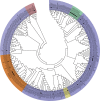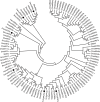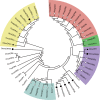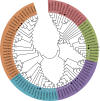Antennal transcriptome analysis of the piercing moth Oraesia emarginata (Lepidoptera: Noctuidae)
- PMID: 28614384
- PMCID: PMC5470721
- DOI: 10.1371/journal.pone.0179433
Antennal transcriptome analysis of the piercing moth Oraesia emarginata (Lepidoptera: Noctuidae)
Abstract
The piercing fruit moth Oraesia emarginata is an economically significant pest; however, our understanding of its olfactory mechanisms in infestation is limited. The present study conducted antennal transcriptome analysis of olfactory genes using real-time quantitative reverse transcription PCR analysis (RT-qPCR). We identified a total of 104 candidate chemosensory genes from several gene families, including 35 olfactory receptors (ORs), 41 odorant-binding proteins, 20 chemosensory proteins, 6 ionotropic receptors, and 2 sensory neuron membrane proteins. Seven candidate pheromone receptors (PRs) and 3 candidate pheromone-binding proteins (PBPs) for sex pheromone recognition were found. OemaOR29 and OemaPBP1 had the highest fragments per kb per million fragments (FPKM) values in all ORs and OBPs, respectively. Eighteen olfactory genes were upregulated in females, including 5 candidate PRs, and 20 olfactory genes were upregulated in males, including 2 candidate PRs (OemaOR29 and 4) and 2 PBPs (OemaPBP1 and 3). These genes may have roles in mediating sex-specific behaviors. Most candidate olfactory genes of sex pheromone recognition (except OemaOR29 and OemaPBP3) in O. emarginata were not clustered with those of studied noctuid species (type I pheromone). In addition, OemaOR29 was belonged to cluster PRIII, which comprise proteins that recognize type II pheromones instead of type I pheromones. The structure and function of olfactory genes that encode sex pheromones in O. emarginata might thus differ from those of other studied noctuids. The findings of the present study may help explain the molecular mechanism underlying olfaction and the evolution of olfactory genes encoding sex pheromones in O. emarginata.
Conflict of interest statement
Figures











Similar articles
-
Antennal transcriptome analysis and comparison of olfactory genes in two sympatric defoliators, Dendrolimus houi and Dendrolimus kikuchii (Lepidoptera: Lasiocampidae).Insect Biochem Mol Biol. 2014 Sep;52:69-81. doi: 10.1016/j.ibmb.2014.06.006. Epub 2014 Jul 3. Insect Biochem Mol Biol. 2014. PMID: 24998398
-
Olfactory Gene Families in Scopula subpunctaria and Candidates for Type-II Sex Pheromone Detection.Int J Mol Sci. 2022 Dec 12;23(24):15775. doi: 10.3390/ijms232415775. Int J Mol Sci. 2022. PMID: 36555416 Free PMC article.
-
Identification of candidate chemosensory genes by transcriptome analysis in Loxostege sticticalis Linnaeus.PLoS One. 2017 Apr 19;12(4):e0174036. doi: 10.1371/journal.pone.0174036. eCollection 2017. PLoS One. 2017. PMID: 28423037 Free PMC article.
-
Sex pheromones and olfactory proteins in Antheraea moths: A. pernyi and A. polyphemus (Lepidoptera: Saturniidae).Arch Insect Biochem Physiol. 2020 Oct;105(2):e21729. doi: 10.1002/arch.21729. Epub 2020 Aug 6. Arch Insect Biochem Physiol. 2020. PMID: 32761939 Review.
-
Soluble proteins in insect chemical communication.Cell Mol Life Sci. 2006 Jul;63(14):1658-76. doi: 10.1007/s00018-005-5607-0. Cell Mol Life Sci. 2006. PMID: 16786224 Free PMC article. Review.
Cited by
-
Odorant Receptors and Odorant-Binding Proteins as Insect Pest Control Targets: A Comparative Analysis.Front Physiol. 2018 Aug 24;9:1163. doi: 10.3389/fphys.2018.01163. eCollection 2018. Front Physiol. 2018. PMID: 30197600 Free PMC article. Review.
-
Antennal Transcriptome of the Fruit-Sucking Moth Eudocima materna: Identification of Olfactory Genes and Preliminary Evidence for RNA-Editing Events in Odorant Receptors.Genes (Basel). 2022 Jul 6;13(7):1207. doi: 10.3390/genes13071207. Genes (Basel). 2022. PMID: 35885990 Free PMC article.
-
Antennal transcriptome analyses and olfactory protein identification in an important wood-boring moth pest, Streltzoviella insularis (Lepidoptera: Cossidae).Sci Rep. 2019 Nov 29;9(1):17951. doi: 10.1038/s41598-019-54455-w. Sci Rep. 2019. PMID: 31784624 Free PMC article.
-
Odorant receptor phylogeny confirms conserved channels for sex pheromone and host plant signals in tortricid moths.Ecol Evol. 2020 Jun 30;10(14):7334-7348. doi: 10.1002/ece3.6458. eCollection 2020 Jul. Ecol Evol. 2020. PMID: 32760532 Free PMC article.
-
Identification of Chemosensory Genes, Including Candidate Pheromone Receptors, in Phauda flammans (Walker) (Lepidoptera: Phaudidae) Through Transcriptomic Analyses.Front Physiol. 2022 Jul 1;13:907694. doi: 10.3389/fphys.2022.907694. eCollection 2022. Front Physiol. 2022. PMID: 35846004 Free PMC article.
References
-
- Riffell JA, Shlizerman E, Sanders E, Abrell L, Medina B, Hinterwirth AJ, et al. (2014) Sensory biology. Flower discrimination by pollinators in a dynamic chemical environment. Science 344: 1515–1518. doi: 10.1126/science.1251041 - DOI - PubMed
-
- Libert S, Zwiener J, Chu X, Vanvoorhies W, Roman G, Pletcher SD (2007) Regulation of Drosophila life span by olfaction and food-derived odors. Science 315: 1133–1137. doi: 10.1126/science.1136610 - DOI - PubMed
-
- Goyret J, Markwell PM, Raguso RA (2008) Context- and scale-dependent effects of floral CO2 on nectar foraging by Manduca sexta. Proc Natl Acad Sci U S A 105: 4565–4570. doi: 10.1073/pnas.0708629105 - DOI - PMC - PubMed
-
- Ando T, Inomata S, Yamamoto M (2004) Lepidopteran sex pheromones. Top Curr Chem 239: 51–96. doi: 10.1007/b95449 - DOI - PubMed
-
- Renou M (2014) Pheromones and General Odor Perception in Insects In: Mucignat-Caretta C, editor. Neurobiology of Chemical Communication. Boca Raton (FL). - PubMed
MeSH terms
Substances
LinkOut - more resources
Full Text Sources
Other Literature Sources

